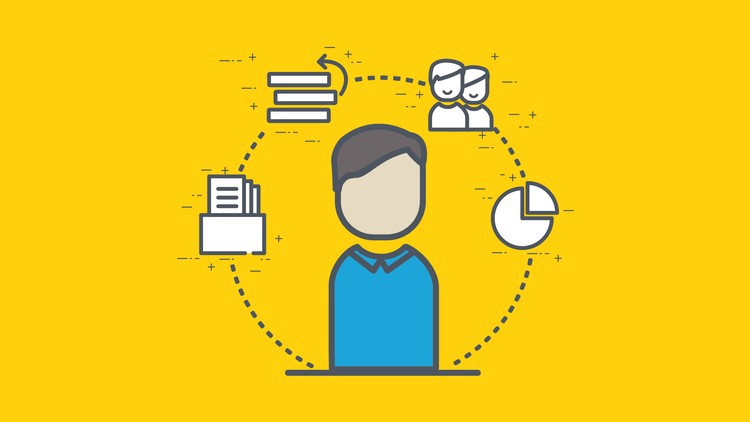Jobs in agile development: what is a product owner?
The product owner plays an important role in modern, agile projects. What are his duties? And how can you become such a Scrum expert yourself? This guide will explain that and more to you.

Where are product owners used?
Nowadays, IT projects are usually no longer implemented according to traditional project management methods. Instead, software products and innovations are created using an agile method such as Scrum.
With so-called Agile Development – for example, according to Scrum – some things are different. On the one hand, the focus is on the rapid, iterative development of the products. On the other hand, some new roles and positions contribute to the implementation. One of them is the Product Owner or PO for short.
What does a Product Owner do?
Within a Scrum process, the Product Owner works closely with the Scrum Master and the development team. Together they advance agile development. This consists – in abbreviated form – of the following several elements:
- the product backlog in which the product owner lists the most important Writes requirements for the product.
- the sprint backlog, in which the tasks for the next sprint are recorded.
- the sprint: usually a two- to three-week phase. In this, the development team – supported by the Scrum Masterworks through the tasks of the Sprint Backlog.
- the product that is gradually created through numerous Scrum sprints.
What are the tasks of the product owner?
The product owner is responsible for a product. He defines its properties and ensures that it is a success. For this to work, the PO must fulfill various tasks:
- regularly exchanges ideas with various stakeholders, for example with the management.
- offset get into the situation of the customers who should use the product. With this knowledge, he writes the so-called user stories – the individual requirements for the product – alone or together with other participants >
- packs the user stories together with tasks, quality requirements, and other things in the product backlog.
- is The main person responsible in the Scrum process for sorting and prioritizing the entries in the Product Backlog.
- ensures ensuring that the tasks in the product backlog are visible and understandable for everyone involved.
- makes or suggests important decisions to better fulfill the product vision.
- has regular meetings with the Scrum Master and the development team.
What are the differences between Product Owner, Project Manager, and Product Manager?
Product Manager (product manager), Product Owner, and Project Manager: Isn’t that kind of the same thing? No. The terms are often used synonymously and their areas of responsibility overlap, but there are a few clear differences. Here is a simplified representation:
- The product manager (PM) develops a product vision, designs the product, and oversees the Marketing Mix (product development, pricing policy, distribution, and advertising). Often a product manager is responsible for several products at the same time.
- The project manager manages the implementation of the product by always keeping an eye on the factors of time, budget, and quality.
- The Product Owner works closely with the development team and the Scrum Master. He takes care of a product and ensures that the product vision is fulfilled.
The tasks and areas of responsibility of the product manager, product owner, and project manager are in theory separate, but in practice they are fluid.
Product Owner, Product Manager, Project Manager and Scrum Master in one person?
In some companies, the product manager acts like a product owner, and the product owner like a project manager. And sometimes the Scrum Master and the Product Owner are also the same people.
If the different tasks and roles are lumped together, this saves costs. This path is understandable for smaller companies that have little staff and budget. And it can work. But it leads to tension and problems because the division of the various tasks among several heads makes sense – like the separation of powers in a state.
If you want to establish a neatly structured, agile development in your company, you should Pay attention to a separation of the different roles. In this way, the Scrum team can play to its full strength without individual people getting into a conflict of interest. And you avoid the product owner being bombarded with tasks, which slows down his performance. Because: Agility means being able to react quickly to changes!
What skills does a product owner have?
Since you as a product owner “dance at several weddings”, you should have T-shaped skills or better have an M profile. That means: ideally you have hard skills and soft skills in different areas.
With the “soft” factors you shine, for example:
- Ability to communicate
- Persuasive power
- Ability to work in a team
- curiosity
- empathy
Why? As a product owner, you deal with different parties every day. Among other things, you will exchange ideas with the stakeholders, the Scrum Master, and the development team. You listen to their suggestions, get feedback on the project, and have problems to solve. Besides, you always have to think about the product vision and the end customer.
So several forces are draining you. Use clear communication, empathy, leadership, and structured thinking to ensure that one thing wins in the end: the product. Its implementation and success is your top priority.
How do you become a product owner?
Currently, the PO profession cannot be learned either as an apprenticeship or as a degree. Instead, you should have completed a related IT apprenticeship or a suitable degree (for example business informatics or business administration). On this basis, you can build up certified advanced training or advanced training to become a product owner. Then you have the title “Certified Product Owner”.
You must also be familiar with the Scrum framework and other agile development methods. Ideally, you will have worked in software development for a few years before continuing your training as a product owner, for example as a project manager.

In which companies do PO work?
How you can find out in our job exchange for IT jobs and can see on other job portals, POs are sought at companies of all sizes. Startups, agencies, IT service providers, medium-sized companies, and large corporations are all looking for special Scrum experts.
Product owners come, for example, in the SAP environment, used in e-commerce, in the real estate industry, and public television. Everywhere where products are developed using an agile method – mostly Scrum.
Not every product owner is permanently employed by a company. Since agile professionals are in great demand, there are more and more freelancers who offer their services as independent product owners.
What does a Product Owner earn?
The salary of a PO is around 3,500 to 5,500 euros gross per month or 42,000 to 66,000 euros per year. On average, the annual earnings of a product owner are 55,000 euros, which corresponds to around 4,600 euros gross per month.
In our job advertisements for product owners, most companies offer an attractive salary as well as an attractive salary further benefits. These include, for example, flexible working hours, job tickets and travel allowances, a company pension scheme, sports offers, and success-based bonuses.
If you become self-employed as a product owner, you can set an hourly rate between 65 and 100 euros or 500 to 800 euros per day request net. A fully utilized freelancer and experienced product owner earns 100,000 euros and more a year.

